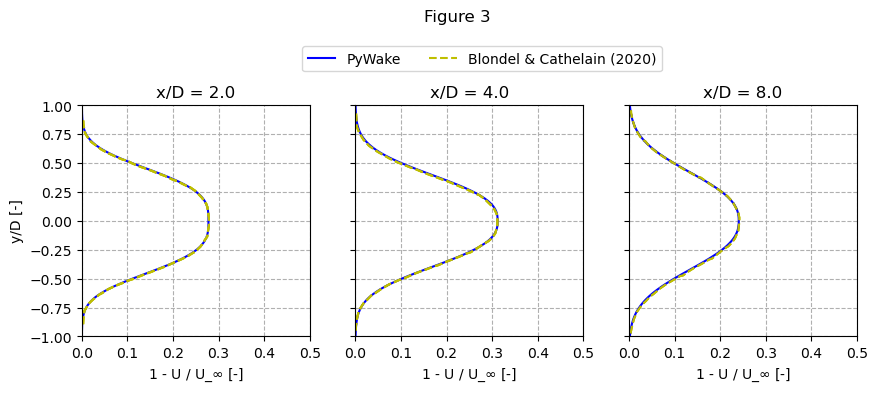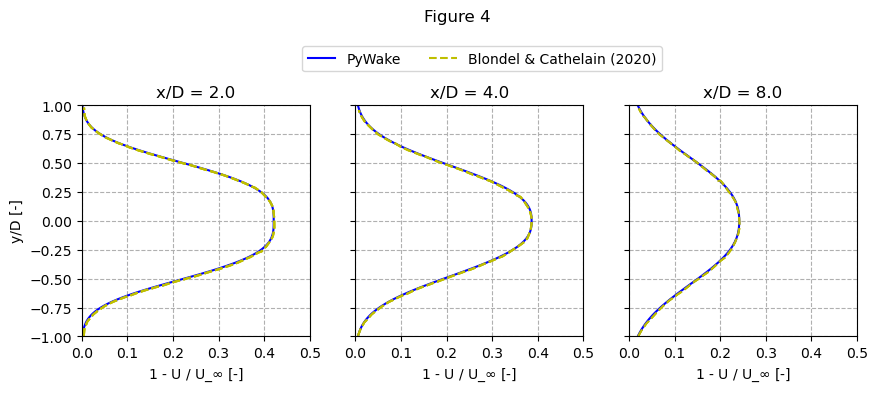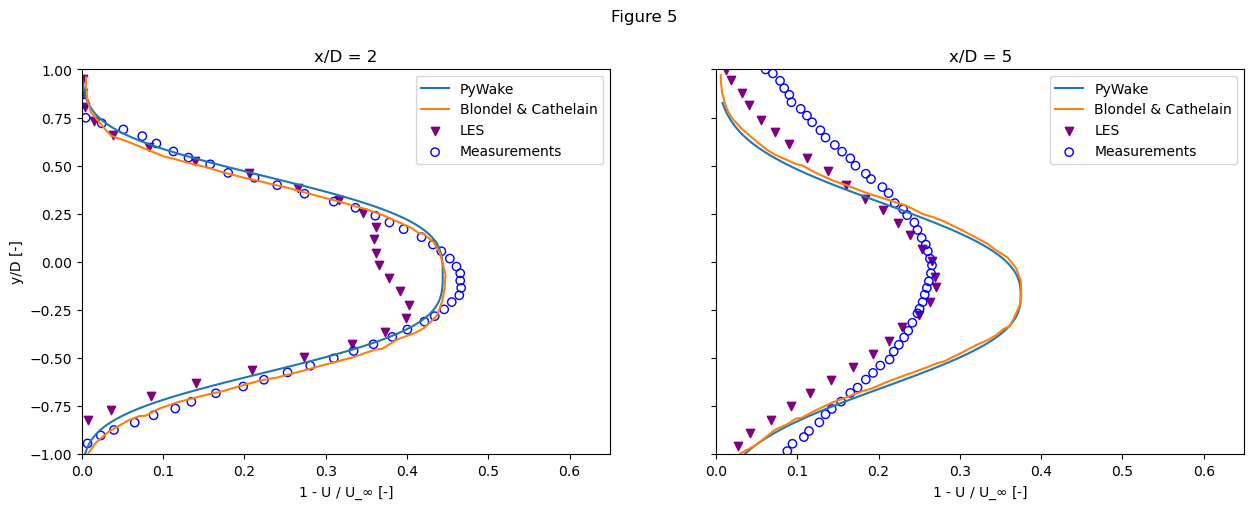Super Gaussian Wake Deficit Model
This notebook reproduces the results of the paper describing the super gaussian wake model:
Blondel and Cathelain: An alternative form of the super-Gaussian wind turbine wake model, Wind Energ. Sci., 5, 1225–1236, (2020), https://doi.org/10.5194/wes-5-1225-2020.
[1]:
# Install PyWake if needed
try:
import py_wake
except ModuleNotFoundError:
!pip install git+https://gitlab.windenergy.dtu.dk/TOPFARM/PyWake.git
Loading objects
[2]:
import numpy as np
import matplotlib.pyplot as plt
from py_wake.examples.data.hornsrev1 import Hornsrev1Site, V80
windTurbines = V80()
site = Hornsrev1Site()
# general variables used for calculations
wt_x, wt_y = [0], [0]
U_inf = 10
D = windTurbines.diameter()
h = windTurbines.hub_height()
y = np.linspace(-1*D, 1*D, 120)
Defining wind farm model
In this example we use the class Blondel_Cathelain_2020 for the wind farm model as it corresponds to the calibrated parameters shown in the reference paper. As default, the wakes are added linearly following Shapiro (2019) https://www.mdpi.com/1996-1073/12/15/2956 and there is no turbulence model. However the Crespo Hernandez is recommended and used to account for the turbulence intensity within the velocity deficit calculation.
[3]:
from py_wake.literature.gaussian_models import Blondel_Cathelain_2020
from py_wake.turbulence_models import CrespoHernandez
wfm = Blondel_Cathelain_2020(site, windTurbines, turbulenceModel=CrespoHernandez())
The cases to be replicated correspond to Figures 3 and 4 for the normalized velocity deficit at three downstream distances from the turbine’s rotor, for cases of low and high turbulence. The cases chosen are:
CT = 0.43, TI = 5%
CT = 0.73, TI = 12%
[4]:
# getting points extracted from paper
def get_data(path_data):
data = np.genfromtxt(path_data)
points_x = data[:,0]
points_y = data[:,1]
return points_x, points_y
Low turbulence case
Specifying path for data files and getting points.
[5]:
# x/D = 2
path_2xD_l = r"data/Super_Gaussian/2_x_D_lowti.dat"
xd_2_points_l, yd_2_points_l = get_data(path_2xD_l)
# x/D = 4
path_4xD_l = r"data/Super_Gaussian/4_x_D_lowti.dat"
xd_4_points_l, yd_4_points_l = get_data(path_4xD_l)
# x/D = 8
path_8xD_l = r"data/Super_Gaussian/8_x_D_lowti.dat"
xd_8_points_l, yd_8_points_l = get_data(path_8xD_l)
x_points_l = [xd_2_points_l, xd_4_points_l, xd_8_points_l]
y_points_l = [yd_2_points_l, yd_4_points_l, yd_4_points_l]
[6]:
# selecting corresponding ti and CT
ti = 0.05
windTurbines.ct = lambda ws, **kwargs: 0.43
simres_l = wfm(wt_x, wt_y, wd=270, ws=U_inf, TI=ti)
[7]:
xD = [2*D, 4*D, 8*D]
lines = []
fig, ax = plt.subplots(1,3, sharey=True, figsize=(10,3))
for i, x_D in enumerate(xD):
U = simres_l.flow_box(x=x_D, y=y, h=h).WS_eff.values.flatten()
l, = ax[i].plot(1 - U/U_inf, y/D, 'b-')
l1, = ax[0].plot(xd_2_points_l, yd_2_points_l, 'y--')
l2, = ax[1].plot(xd_4_points_l, yd_4_points_l, 'y--')
l3, = ax[2].plot(xd_8_points_l, yd_8_points_l, 'y--')
lines.append(l)
ax[i].set_ylim(-1, 1)
ax[i].set_xlim(0, 0.5)
ax[i].set_title(f'x/D = {x_D/D}')
ax[0].set_ylabel('y/D [-]')
ax[i].set_xlabel('1 - U / U_$\infty$ [-]')
ax[i].grid(linestyle='--')
fig.legend((lines[0], l1), ('PyWake', 'Blondel & Cathelain (2020)'), ncol=2, loc='upper center', bbox_to_anchor=(0, 0, 1.05, 1.1), numpoints=1, scatterpoints=1)
fig.suptitle('Figure 3', y=1.2)
[7]:
Text(0.5, 1.2, 'Figure 3')

High turbulence case
Specifying path for data files and getting points.
[8]:
# x/D = 2
path_2xD_h = r"data/Super_Gaussian/2_x_D_highti.dat"
xd_2_points_h, yd_2_points_h = get_data(path_2xD_h)
# x/D = 4
path_4xD_h = r"data/Super_Gaussian/4_x_D_highti.dat"
xd_4_points_h, yd_4_points_h = get_data(path_4xD_h)
# x/D = 8
path_8xD_h = r"data/Super_Gaussian/8_x_D_highti.dat"
xd_8_points_h, yd_8_points_h = get_data(path_8xD_h)
x_points_h = [xd_2_points_h, xd_4_points_h, xd_8_points_h]
y_points_h = [yd_2_points_h, yd_4_points_h, yd_4_points_h]
[9]:
# selecting corresponding ti and CT
ti = 0.12
windTurbines.ct = lambda ws, **kwargs: 0.73
simres_h = wfm(wt_x, wt_y, wd=270, ws=U_inf, TI=ti)
[10]:
xD = [2*D, 4*D, 8*D]
lines = []
fig, ax = plt.subplots(1,3, sharey=True,figsize=(10,3))
for i, x_D in enumerate(xD):
U = simres_h.flow_box(x=x_D, y=y, h=h).WS_eff.values.flatten()
l, = ax[i].plot(1 - U/U_inf, y/D, 'b-')
l1, = ax[0].plot(xd_2_points_h, yd_2_points_h, 'y--')
l2, = ax[1].plot(xd_4_points_h, yd_4_points_h, 'y--')
l3, = ax[2].plot(xd_8_points_h, yd_8_points_h, 'y--')
lines.append(l)
ax[i].set_ylim(-1, 1)
ax[i].set_xlim(0, 0.5)
ax[i].set_title(f'x/D = {x_D/D}')
ax[0].set_ylabel('y/D [-]')
ax[i].set_xlabel('1 - U / U_$\infty$ [-]')
ax[i].grid(linestyle='--')
fig.legend((lines[0], l1), ('PyWake', 'Blondel & Cathelain (2020)'), ncol=2, loc='upper center', bbox_to_anchor=(0, 0, 1.05, 1.1), numpoints=1, scatterpoints=1)
fig.suptitle('Figure 4', y=1.2)
[10]:
Text(0.5, 1.2, 'Figure 4')

Comparison with measurements
The implementation of the model is now compared to data from experimental campaigns as well as the analytical model derived by the authors. A set of data containing lidar measurements is used for the comparison, at the wake behind a full scale wind turbine. Two cases were recorded: stable and nearly neutral atmosphere; however for the purpose of this example only a high turbulence case in the nearly neutral atmosphere will be considered, as it also contains LES data from a SOFWA (Simulator fOrWind Farm Applications; Churchfield et al., 2012) simulation.
The case to be studied corresponds to:
High turbulence example
CT: 0.75, TI: 10.7%
Specifying path for data files and getting points.
[11]:
# high turbulence case - measurements
# x/D = 2
path_2xD_mh = r"data/Super_Gaussian/2_x_D_meas_highti.dat"
xd_2_points_mh, yd_2_points_mh = get_data(path_2xD_mh)
# x/D = 5
path_5xD_mh = r"data/Super_Gaussian/5_x_D_meas_highti.dat"
xd_5_points_mh, yd_5_points_mh = get_data(path_5xD_mh)
# high turbulence case - LES
# x/D = 2
path_2xD_les = r"data/Super_Gaussian/2_x_D_LES_highti.dat"
xd_2_points_les, yd_2_points_les = get_data(path_2xD_les)
# x/D = 5
path_5xD_les = r"data/Super_Gaussian/5_x_D_LES_highti.dat"
xd_5_points_les, yd_5_points_les = get_data(path_5xD_les)
# high turbulence case - super gaussian analytical
path_2xD_sp = r"data/Super_Gaussian/2_x_D_sp_highti.dat"
xd_2_points_sp, yd_2_points_sp = get_data(path_2xD_sp)
path_5xD_sp = r"data/Super_Gaussian/5_x_D_sp_highti.dat"
xd_5_points_sp, yd_5_points_sp = get_data(path_5xD_sp)
[12]:
# selecting corresponding ti and CT
ti = 0.107
windTurbines.ct = lambda ws, **kwargs: 0.75
simres_mh = wfm(wt_x, wt_y, wd=270, ws=U_inf, TI=ti)
[13]:
fig, (ax1, ax2) = plt.subplots(1, 2, sharey=True, figsize=(15,5))
offset = -0.06478737727060202
U_2xd = simres_mh.flow_box(x=2*D, y=y, h=h).WS_eff.values.flatten()
ax1.plot(1 - U_2xd/U_inf, y/D + offset, label='PyWake')
ax1.plot(xd_2_points_sp, yd_2_points_sp, label='Blondel & Cathelain')
ax1.scatter(xd_2_points_les, yd_2_points_les, marker='v', facecolor='purple', label='LES')
ax1.scatter(xd_2_points_mh, yd_2_points_mh, marker='o', facecolor='None', edgecolor= 'blue',label='Measurements')
ax1.set_title('x/D = 2')
ax1.set_ylim([-1,1])
ax1.set_xlim([0,0.65])
ax1.set_ylabel('y/D [-]')
ax1.set_xlabel('1 - U / U_$\infty$ [-]')
ax1.legend(loc='upper right')
offset = -0.1738105526986733
U_5xd = simres_mh.flow_box(x=5*D, y=y, h=h).WS_eff.values.flatten()
ax2.plot(1 - U_5xd/U_inf, y/D + offset, label='PyWake')
ax2.plot(xd_5_points_sp, yd_5_points_sp, label='Blondel & Cathelain')
ax2.scatter(xd_5_points_les, yd_5_points_les, marker='v', facecolor='purple', label='LES')
ax2.scatter(xd_5_points_mh, yd_5_points_mh, marker='o', facecolor='None', edgecolor= 'blue',label='Measurements')
ax2.set_title('x/D = 5')
ax2.set_ylim([-1,1])
ax2.set_xlim([0,0.65])
ax2.set_xlabel('1 - U / U_$\infty$ [-]')
ax2.legend(loc='upper right')
fig.suptitle('Figure 5', y=1)
[13]:
Text(0.5, 1, 'Figure 5')

The model seems to capture the wake profile pretty well in the near wake, however it tends to overestimate the maximum velocity deficit at the far wake.
